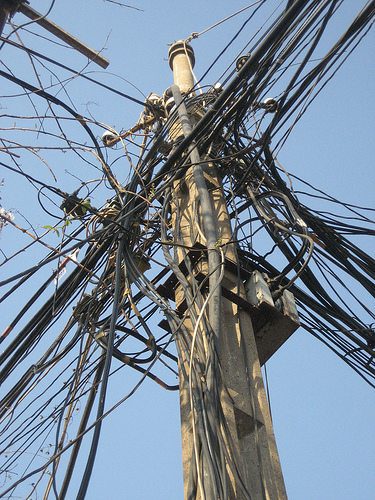For goodness sake.
It’s almost 2014 and the best that our new Abbott-led government can come up with by way of an energy policy is a seven-page document loaded with out-of-date graphs, deceptive statements and, frankly, a copy and paste of many of the policies the preceding government put in place.
Page one describes how electricity prices have risen a lot. Groundbreaking news. It then launches into an out-of-date and deceptive statement about rising demand (which is wrong, demand is actually falling) and goes on to say, ‘actually, it’s a state issue, it’s not our fault, but we’ll work with them’.
Page two, predictably, launches straight into a carbon tax assault. Intriguingly, the prime minister seems to be backflipping on his statements already about how much axing the Carbon Price will save. On October 15, he said: ‘When [the carbon tax repeal] bill is passed, Australian households will be better off to the tune of $550 a year.” However, in this ‘Fact Sheet’, the number has been reduced by a staggering 60 per cent to “around $200 a year” lower for electricity and gas and, in 2014-15, a mere $70 annually beyond that.
Fifty bucks says that’ll never be on the front page of The Australian.
Page three and four rightly describe networks costs as the major contributor to electricity costs and then go on to explain that it’s a big country, the network is really old and, in effect, justifies increased expenditure. There is scant attention paid to the real issue that, in many jurisdictions, these government-owned assets are allowed to make a return based on the value of the asset – so expanding them makes more money for state governments.
In two recent cases in NSW, the state-owned transmission owner Transgrid was forced to backpedal on massive network upgrades because: “The latest data showed a solution to electricity growth and supply in the area is not required until the 2020s or later.” This was Transgrid’s statement, after unsuccessfully battling for several years to install the $227 million, 330 kilovolt line near Armidale. Transgrid also lost a, very high profile, case in similar circumstances at nearby Taree earlier this year after they were outed in an ABC documentary (Corridors of Power) about gold-plating. Yet again, Transgrid insisted that one of two options were needed for Stroud-to-Taree with the first option costing $278.8 million and the second, $349 million. They lost that one, too.
Nothing in our new government’s Fact Pack mentions these cases or the urgent need for overhaul of the regulations that allowed these projects to almost proceed.
Network and transmission owners certainly do face a conundrum. If demand keeps falling, they have less kilowatt hours to recover their costs from, so they will have to put their charges up and, under current regulations, are allowed to do so. They thus have virtually zero incentive to encourage reduced demand and are in fact geared in the exact opposite direction.
Here’s a true story about how one senior manager in a network company described it to me recently. I had asked him what we could do, collaboratively, to continue to reduce demand but find a way to make money in a new way, so they could survive. He stared at me blankly, blinking for a minute. “We have a very clear strategy, it’s quite simple,” he said. “We simply need to reduce the price of electricity sufficiently that demand starts to rise again, then we can spread the costs over more kilowatt hours, and that’s it.” His answer was simple, use more electricity.
Now it starts to become clearer why the NSW government may have reversed its ban on electric hot water systems only a year or so back. And perhaps why ‘time of use’ pricing is essentially discouraged. And why the NSW government set out on an unprecedented, calculated campaign to attack and discredit the solar industry in 2011.
Page five of the federal government’s Fact Pack is dedicated to the Renewable Energy Target, feed-in tariffs and energy efficiency schemes. It deceptively describes the cost impact of the RET in 2012-2013 terms (anyone told them that is in the past?) and belies the fact that the RET costs are reducing substantially and in fact also have a positive effect on the cost of electricity.
The document says, “most states and territories have introduced feed-in tariffs” and cites the fact that costs were bigger than expected in the case of NSW. Well, prime minister, that was 2011. Since then virtually every FIT in Australia has been cut or dramatically reduced and as recent Energex data shows there is a constant shedding of high value FIT customers to low value non-FIT schemes as they move house or otherwise become ineligible. Oh, and those nasty FITs added almost 3GW of capacity to Australia.
Energy efficiency gets a little mention, but really only in the sense that it has a cost and little benefit; almost made out to be quirky, odd little programs. Poor energy efficiency.
Page six talks about the COAG reforms that have been going on for years and that have achieved virtually nothing, and again completely overlooks the fact that while ever the state budgets are reliant on revenues from coal royalties, generation, transmission and distribution of electricity, there is no reason that anyone in COAG would suggest any need for change.
The last page waffles on about how you can save energy, use one of the websites to shop around and how they don’t expect prices to go up more than, say, 3 per cent per annum in the next few years. What a wasted opportunity.
Nigel Morris is director of Solar Business Services. This article was originally published on SolarBusinessServices. Reproduced with permisison










